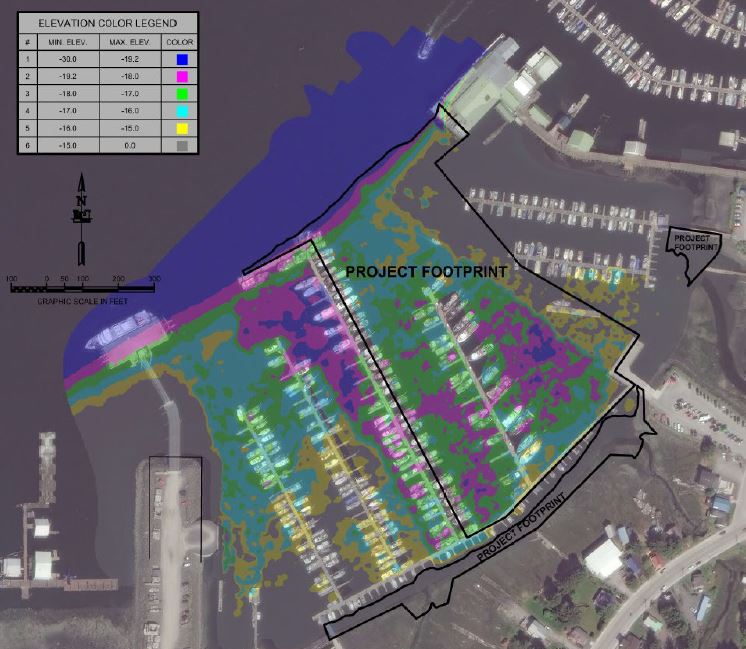
Local officials this week dug into the details of a multi-million dollar dredging project proposed for Petersburg’s South Harbor. The municipality would be required to fund a portion of the dredging work and will have to decide whether to green light the work and how to pay for it. There’s still some uncertainty about the cost of disposing of the dredged material.
The dredging has been studied by the U.S. Army Corps of Engineers. It could begin as soon as next October but depends on Petersburg coming up with its share of the project cost. At the moment the estimated total cost is 10.6 million dollars.
Harbor board chair Bob Martin summed up the latest information before the borough assembly this month.
“We got the price tag on this dredging which has been quietly going in bureaucratic for a couple years now,” Martin said. “It’s a very high price tag. We’re all sort of choked on it but we still have to move forward and decide what to do. There is money to pay for it. It’s kind of the sum total of all the raw fish tax that’s gone to the harbor, well since the North Harbor was done. That would all just go to the dredging plus more. So we haven’t found an alternative. We haven’t had any opposition to speak to the fact that maybe dredging isn’t necessary it seems to be.”
Martin also noted a benefit of the project that the Corps would take over permanent maintenance dredging responsibility on portions of South Harbor. Petersburg took over that harbor from the state in 2000.
The cost estimates at the moment put Petersburg’s share just under 4.8 million dollars for the work. As Martin noted, a good portion of that could be paid out of harbor reserves, leaving the borough looking for an additional 1.7 million dollars that could be paid with a revenue bond or from other borough sources. Borough manager Steve Giesbrecht told the assembly that number comes from the Corps’ estimates and may be lower.
“Their estimates tend to be high,” Giesbrecht said. “And they include a 22 percent contingency. So in both cases that has the opportunity to when the bids actually go out to lower that 1.7 million that we need to come up with down to even a lower level. Is because then we don’t have to borrow all of it. The potential is we end up owing, the harbor ends up owing people a lot less than if we have to do it through a revenue bond or we have to bond the whole thing.”
The cost of disposing of the 82,000 cubic yards of dredged material is still a little uncertain, depending on where the project is permitted for disposal. The proposed disposal site is in Frederick Sound about two and a half miles east of town, in a deep ocean spot that’s traditionally been used for scuttling old boats. Officials with the Army Corps presented the latest information on the project to borough assembly and harbor board members this month and many of the questions focused on those uncertainties.
The corps’ Matt Ferguson described the harbor floor that would be dredged and said the material for the most part is ancient soil, not sand deposited by a nearby creek.
“There’s a little bit of sedimentation from Hammer Slough but most of that stuff moves north, which is probably why the North Harbor had more problems with sediment chemistry, or one of the contributing factors with sediment chemistry in the North Harbor,” Ferguson said.
Ferguson explained that the driving factor behind the increasingly shallow waters in this harbor, like others in Southeast, is rebound of the earth’s crust thousands of years after glacial ice has receded from the area. The dirt is hard enough that the federal agency was not able to remove enough for sampling in some areas. That will require some additional testing to make sure that the dredge spoils can be dumped in Frederick Sound, the least costly option.
Mayor Mark Jensen questioned Ferguson about that determination.
“So in a nutshell we don’t know if all the 80,000 yards can be dumped in the sound yet?” Jensen asked.
“We do not know,” Ferguson responded. “The Corps of Engineers feels that it is suitable for aquatic disposal meaning that we can put it in the ocean somewhere.”
The agency also looked at disposal at a site in Thomas Bay about 20 miles away on the mainland north of Petersburg. Barging that material that distance across Frederick Sound could add millions to the project cost. The Environmental Protection Agency has to sign off on some ocean disposal sites.
Petersburg had to dispose of dredge spoils from North Harbor dredging on land because it tested as too contaminated to return to the ocean. Officials were confident that would not be the case with the South Harbor material.
The local government and federal agency will have to decide whether to sign an agreement on sharing the costs of dredging and disposal. Under that agreement the federal government would pay most of the cost of dredging a main entrance and basins used by most boats in that harbor. But that would won’t happen without Petersburg funding the full amount for dredging around several of the finger floats and the in-shore side of the harbor. If the borough says yes, the Corps will do more design work and analysis next year before seeking a company to do the work.
On the Corps’ website, documents are available for review, under the civil works heading.
Also, here’s an article by the Army Corps about surveying the disposal site.











